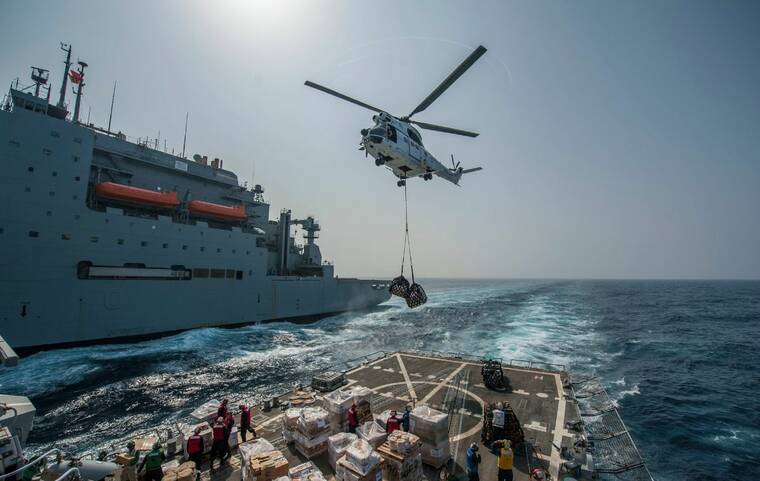Navy warships deploy as Russian fleet makes close pass to Florida

U.S. NAVY / MASS COMMUNICATION SPECIALIST 3RD CLASS SCOTT BARNES
An SA-330J Puma helicopter drops supplies on the flight deck of the Arleigh Burke-class guided-missile destroyer USS Truxtun (DDG 103), in April 2014, during a vertical replenishment with the Military Sealift Command dry cargo and ammunition ship USNS Richard E. Byrd (T-AKE 4). The U.S. Navy has deployed warships and aircraft to track a Russian naval flotilla after the Russian vessels sailed less than 30 miles off South Florida’s coast today, U.S. officials told McClatchy and the Miami Herald.
The U.S. Navy has deployed warships and aircraft to track a Russian naval flotilla after the Russian vessels sailed less than 30 miles off South Florida’s coast today, U.S. officials told McClatchy and the Miami Herald.
Last week, Moscow sent three ships and a nuclear-powered submarine to the Caribbean for what U.S. officials say will be a set of extensive military air and naval exercises — the first of their kind in at least five years.
While the Biden administration has said it is not concerned by the Russian activity, it has nevertheless authorized the deployment of three powerful destroyers and a submarine reconnaissance aircraft to the region, a U.S. Northern Command official told McClatchy and the Herald today.
“In accordance with standard procedures, we’ve been actively monitoring the Russian ships as they transit the Atlantic Ocean within international waters,” the NORTHCOM official said. “Air and maritime assets under U.S. Northern Command have conducted operations to ensure the defense of the United States and Canada. Russia’s deployments are part of routine naval activity which pose no direct threat or concern to the United States.”
The U.S. deployment includes three guided-missile destroyers — the USS Truxtun, USS Donald Cook and USS Delbert D. Black — as well as a Coast Guard cutter, the Stone, and a Boeing P-8 maritime patrol aircraft.
Last week, confirming Russia’s deployment plans, a senior administration official said the U.S. Navy would adopt “whatever the necessary posture is to track and to monitor” their activity as the exercises unfold.
Don't miss out on what's happening!
Stay in touch with breaking news, as it happens, conveniently in your email inbox. It's FREE!
An additional port call by the Russian ships is possible in Venezuela, multiple officials said. The Biden administration anticipates the exercises will culminate in worldwide naval exercises by Russia that will include deployments from the Caribbean to the South Pacific.
The U.S. intelligence community has assessed that none of the Russian vessels is carrying nuclear weapons.
The Cuban Revolutionary Armed Forces said last week that the Russian missile frigate Admiral Gorshkov, the nuclear submarine Kazan, the oil tanker Pashin and the salvage tug Nikolai Chiker would arrive June 12 and stay for a week.
Users of the website marinetraffic.com have been tracking the position of the U.S. and Russian ships in recent days. According to the website, the Russian sea rescue tug Nikolay Chiker was positioned 26 nautical miles from Key Largo on this morning.
U.S. officials acknowledged the close call of the Russian ships, while emphasizing they have remained in international waters.
“We have been monitoring the ships’ paths closely,” a U.S. official said today. “At no point have the ships or submarine posed a direct threat to the United States.”
GLOBAL DEPLOYMENTS
The Port of Havana will be particularly crowded this week.
On top of the Russian warships and the nuclear-powered submarine expected to arrive on Wednesday, HMCS Margaret Brooke, a patrol vessel for the Royal Canadian Navy, will arrive Friday and stay until Monday, when the Russian ships are expected to leave.
The Communist Party newspaper Granma said the ship’s visit highlights the “50th anniversary of cooperation ties” with Canada and the “bilateral collaboration for the maintenance of peace in our region.” It did not mention the simultaneous presence of Russian navy assets at the port.
A Venezuelan training ship, the AB Simón Bolívar, will also visit Santiago de Cuba, the island’s second-largest city, from Saturday to June 19.



